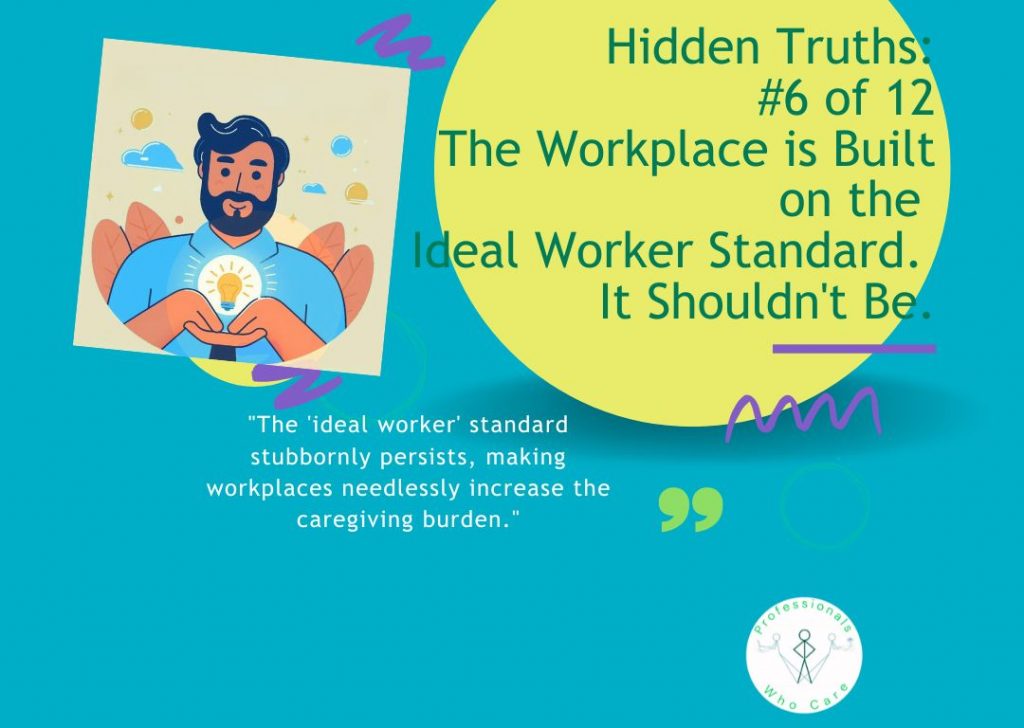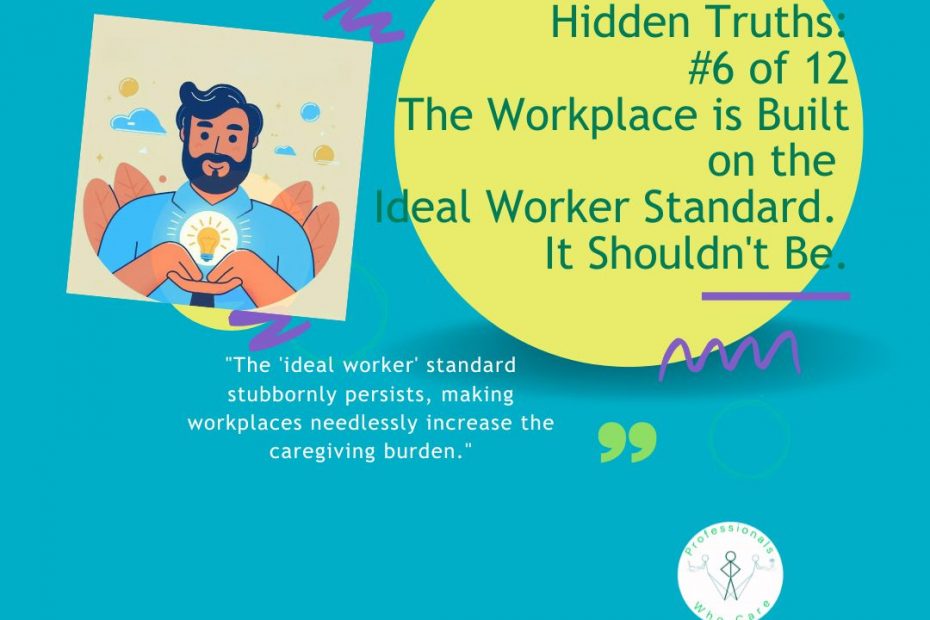
Hidden Truths Series: #6 of 12
By Mark Fukae, Founder of the Caregiver Advocacy and Support Initiative (CASI) and Director of Advocacy for Professionals Who Care
At the Caregiver Advocacy and Support Initiative (CASI), an important initiative of Professionals Who Care, we intimately understand the profound challenges caregivers face. As CASI’s Founder, and personally navigating the complex demands of caring for my 93-year-old mother with end-stage dementia, I see firsthand how the modern workplace often feels fundamentally misaligned with the lives we actually lead. The expectations are rooted in an outdated model, one that simply doesn’t reflect the realities of today’s families and economy. This disconnect is one of the most significant “Hidden Truths” contributing to caregiver burden that CASI seeks to address.
Much of the workplace has unfortunately rooted its notions of success on what is known as the “ideal worker” archetype. This standard first arose in the late eighteenth century as part of the industrial revolution and is widely seen as last relevant in the 1950s. The ideal worker standard defines successful employee behavior as one focused entirely on the job from 9-5, uninterrupted, and in-person. The system was designed with the implicit assumption that each worker would fully devote their attention to their job, with another person (typically a non-working spouse or family family member) at home to manage all household, family, and community duties.
Society has changed greatly since the 1950s, yet the “ideal worker standard” stubbornly persists, making workplaces needlessly increase the caregiving burden.
Families Have Changed
Today, we’ve seen a significant rise in single-parent and dual-income homes, meaning that employees must manage both work and family responsibilities simultaneously. Most employees simply do not have an adult at home who exclusively manages family and community tasks during work hours. This fundamental shift renders the “ideal worker” model obsolete for the vast majority of the workforce.
Economy Has Changed
Our current economy, marked by a high cost of living, increases the pressure for all able adults in a household to work. Prices have soared for essentials like housing, food, childcare, education, and medical care, far outpacing income increases. Most families are struggling to make ends meet, making a single-earner household increasingly unsustainable. In this economic reality, the rigid “ideal worker” schedule simply does not work for our economy or for the families trying to participate in it.
Technology Has Changed
Technology has erased many previous barriers of what can be accomplished outside the physical walls of work. Innovations like remote work, virtual meetings, paperless environments, and virtual gathering and networking opportunities have fundamentally changed the definition of what is possible in terms of work flexibility. The COVID-19 pandemic served as a global, undeniable proof-of-concept that flexibility is not only possible but can be highly effective, thanks to our existing technological infrastructure.
The Definition of Workplace Success Must Change
Despite these profound and undeniable societal changes, many employers consciously and unconsciously continue to elevate the outdated ideal worker construct. This adherence to an anachronistic model often leads to significant challenges, including widespread discrimination against caregivers, particularly mothers, in the workplace.
At CASI, we believe workplace success should not be based on adherence to an outdated model, but rather on a more inclusive standard that measures success based on outcomes and results. This paradigm shift is essential for creating equitable and sustainable workplaces for all caregivers and families.
Your Voice Matters
The “ideal worker” standard is a pervasive hidden truth that contributes significantly to the caregiving crisis. Acknowledging its harmful impact is the first step. The next is to advocate for policies and cultural shifts that recognize the diverse realities of today’s workforce.
Join CASI in shining a light on these “Hidden Truths” and advocating for a future where workplaces support, rather than hinder, the vital work of caregiving.
Your Voice is Crucial. Take Action!
Your support directly fuels CASI’s advocacy efforts and helps us push forward the Federal and Colorado CARE Act proposals.
- Sign CASI’s Petition: Help us build momentum by signing CASI’s petition on Change.org today! [Link to Change.org Petition]
- Support CASI & Professionals Who Care: Learn more about how you can contribute to the Caregiver Advocacy and Support Initiative (CASI) and its parent organization, Professionals Who Care (PWC). [Link to CASI/PWC Website]
Resources for the Ideal Worker Standard
- Bornstein, S., Williams, J. C., & Painter, G. R. (2012). Discrimination against Mothers Is the Strongest Form of Workplace Gender Discrimination: Lessons from US Caregiver Discrimination Law. International Journal of Comparative Labour Law & Industrial Relations, 28(1), 45–62.
- Cech, E. A., & O’Connor, L. T. (2017). ‘Like second-hand smoke’: the toxic effect of workplace flexibility bias for workers’ health. Community, Work & Family, 20(5), 543–572. https://doi.org/10.1080/13668803.2017.1371673
- Hirsh, C. E., Treleaven, C., & Fuller, S. (2020). Caregivers, Gender, and the Law: An Analysis of Family Responsibility Discrimination Case Outcomes. Gender & Society, 34(5), 760–789. https://doi.org/10.1177/0891243220946335
- O’Connor, L. T., & Cech, E. A. (2018). Not Just a Mothers’ Problem: The Consequences of Perceived Workplace Flexibility Bias for All Workers. Sociological Perspectives, 61(5), 808–829. https://doi.org/10.1177/0731121418768235
- Williams, J. C. (2006). One sick child away from being fired: When ‘opting out’ is not an option. SSRN Electronic Journal. https://doi.org/10.2139/ssrn.2126303
